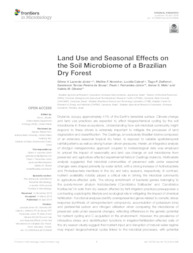Land use and seasonal effects on the soil microbiome of a Brazilian dry forest.
Land use and seasonal effects on the soil microbiome of a Brazilian dry forest.
Author(s): LACERDA JÚNIOR, G. V.; NORONHA, M. F.; CABRAL, L.; DELFORNO, T. P.; SOUSA, S. T. P. de; FERNANDES JUNIOR, P. I.; MELO, I. S.; OLIVEIRA. V. M.
Summary: Drylands occupy approximately 41% of the Earth?s terrestrial surface. Climate change and land use practices are expected to affect biogeochemical cycling by the soil microbiome in these ecosystems. Understanding how soil microbial community might respond to these drivers is extremely important to mitigate the processes of land degradation and desertification. The Caatinga, an exclusively Brazilian biome composed of an extensive seasonal tropical dry forest, is exposed to variable spatiotemporal rainfall patterns as well as strong human-driven pressures. Herein, an integrated analysis of shotgun metagenomics approach coupled to meteorological data was employed to unravel the impact of seasonality and land use change on soil microbiome from preserved and agriculture-affected experimental fields in Caatinga drylands. Multivariate analysis suggested that microbial communities of preserved soils under seasonal changes were shaped primarily by water deficit, with a strong increase of Actinobacteria and Proteobacteria members in the dry and rainy seasons, respectively. In contrast, nutrient availability notably played a critical role in driving the microbial community in agriculture-affected soils. The strong enrichment of bacterial genera belonging to the poorly-known phylum Acidobacteria (?Candidatus Solibacter? and ?Candidatus Koribacter?) in soils from dry season affected by ferti-irrigation practices presupposes a contrasting copiotrophic lifestyle and ecological role in mitigating the impact of chemical fertilization. Functional analyses identify overrepresented genes related to osmotic stress response (synthesis of osmoprotectant compounds, accumulation of potassium ions) and preferential carbon and nitrogen utilization when comparing the microbiome of preserved soils under seasonal changes, reflecting differences in the genetic potential for nutrient cycling and C acquisition in the environment. However, the prevalence of nitrosative stress and denitrification functions in irrigation/fertilization-affected soils of the dry season clearly suggest that nutrient input and disruption of natural water regime may impact biogeochemical cycles linked to the microbial processes, with potential impacts on the ecosystem functionality. These findings help to better understand how natural seasonality and agricultural management differentially affect soil microbial ecology from dry forests, providing support for the development of more sustainable land management in dryland ecosystems.
Publication year: 2019
Types of publication: Journal article
Unit: Embrapa Semi-arid Region
Observation
Some of Embrapa's publications are published as ePub files. To read them, use or download one of the following free software options to your computer or mobile device. Android: Google Play Books; IOS: iBooks; Windows and Linux: Calibre.
Access other publications
Access the Agricultural Research Database (BDPA) to consult Embrapa's full library collection and records.
Visit Embrapa Bookstore to purchase books and other publications sold by Embrapa.

